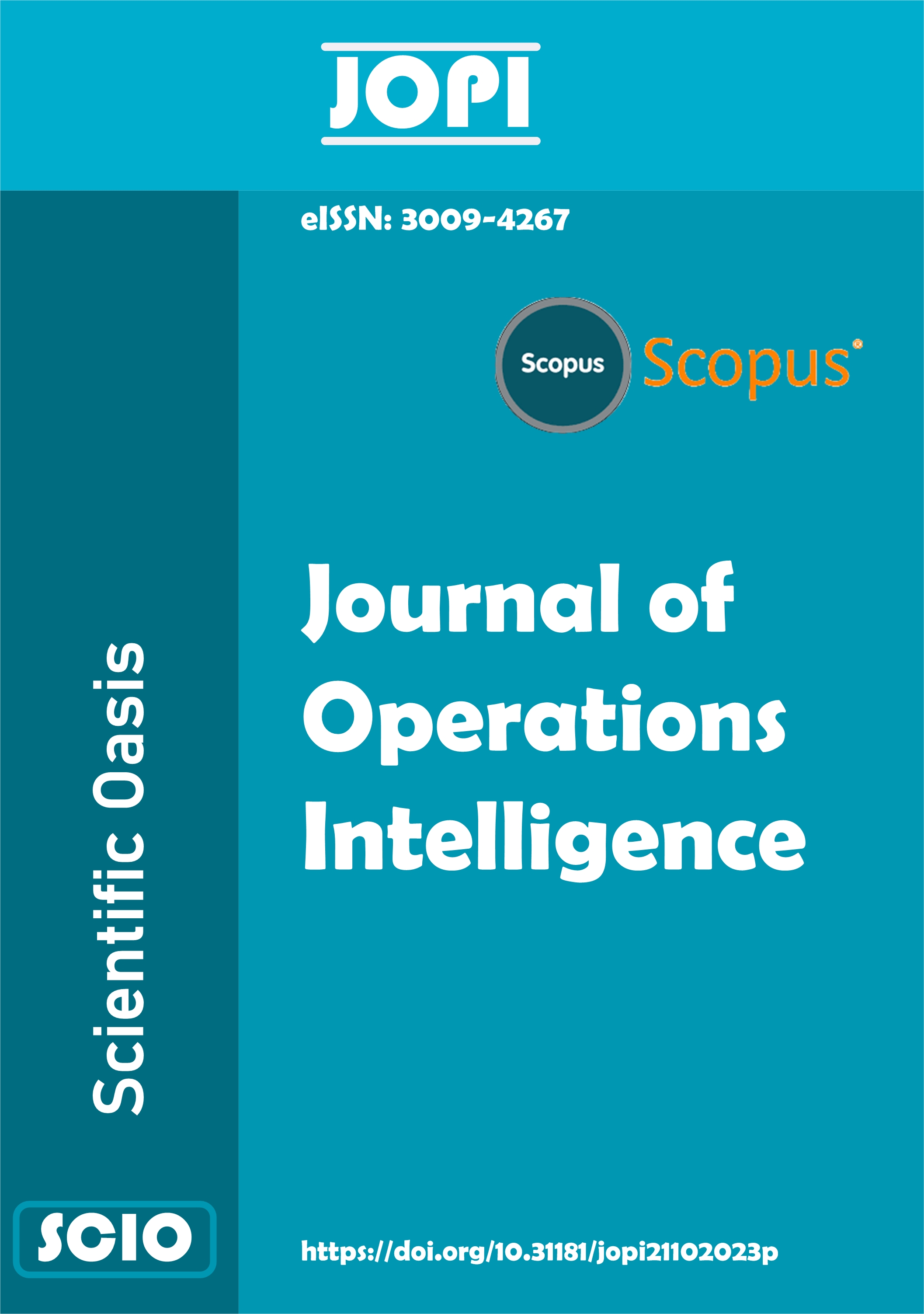A Data Evolvement Analysis for Sustainable Performance Evaluation of Educational Resource Use in Architecture Universities
DOI:
https://doi.org/10.31181/jopi31202549Keywords:
Architecture Universities, Data Envelopment Analysis, Sustainable Development, Scale EfficiencyAbstract
In the context of China’s dual-carbon strategy and the ongoing promotion of green campus initiatives, efficient resource allocation in universities, particularly architecture-focused institutions, has garnered growing attention. This study evaluates 28 architecture universities in mainland China using Data Envelopment Analysis (DEA), applying standardized input–output indicators. The analysis examines three key dimensions: technical efficiency (TE), pure technical efficiency (PTE), and scale efficiency (SE). The results indicate that while many universities exhibit strong managerial efficiency, significant disparities in scale efficiency persist, suggesting widespread misalignments between institutional size and resource utilization. Further classification based on returns to scale (RTS) reveals distinct inefficiency types, providing a foundation for targeted improvement strategies. The study concludes with policy recommendations aimed at differentiated resource optimization and sustainable campus development, offering practical insights to enhance the green performance and long-term sustainability of architecture universities.
Downloads
References
Fissi, S., Romolini, A., Gori, E., et al. (2021). The path toward a sustainable green university: The case of the University of Florence. Journal of Cleaner Production, 279, 123655. https://doi.org/10.1016/j.jclepro.2020.123655
Tagliabue, L. C., Cecconi, F. R., Maltese, S., et al. (2021). Leveraging digital twin for sustainability assessment of an educational building. Sustainability, 13(2), 480. https://doi.org/10.3390/su13020480
Li, Y., Chen, H., & Yu, P. (2024). Green campus transformation in smart city development: A study on low-carbon and energy-saving design for the renovation of school buildings. Smart Cities, 7(5), 2940–2965. https://doi.org/10.3390/smartcities7050115
Kaan, M., Bozkurt, A., Genç, M. S., et al. (2024). Optimization study of an energy storage system supplied solar and wind energy sources for green campus. Process Safety and Environmental Protection, 190, 863–872. https://doi.org/10.1016/j.psep.2024.07.066
Zheng, N., Li, S., Wang, Y., et al. (2021). Research on low-carbon campus based on ecological footprint evaluation and machine learning: A case study in China. Journal of Cleaner Production, 323, 129181. https://doi.org/10.1016/j.jclepro.2021.129181
Ribeiro, J. M. P., Hoeckesfeld, L., Dal Magro, C. B., et al. (2021). Green Campus Initiatives as sustainable development dissemination at higher education institutions: Students’ perceptions. Journal of Cleaner Production, 312, 127671. https://doi.org/10.1016/j.jclepro.2021.127671
Rusli, N., Hussain, M. R. M., Nizarudin, N. D., et al. (n.d.). The implications of epistemology on knowledge and awareness in green campus management. [Journal name and other details missing]
Hao, J., Ye, X., Yu, C., et al. (2023). A novel individual carbon emission evaluation and carbon trading model for low-carbon university campuses. Sustainability, 15(22), 15928. https://doi.org/10.3390/su152215928
Sun, X., Gao, W., Zhao, M., et al. (2024). Optimize green campus sustainable construction from users’ perspective. Environment, Development and Sustainability, 1–34. https://doi.org/10.1007/s10668-024-04580-y
Güven, A. F., Yörükeren, N., & Samy, M. M. (2022). Design optimization of a stand-alone green energy system of university campus based on Jaya-Harmony Search and Ant Colony Optimization algorithms approaches. Energy, 253, 124089. https://doi.org/10.1016/j.energy.2022.124089
Chen, C., Guo, B. R., Liu, S. Q., et al. (2024). Strategies for developing low-carbon university campuses in China within the context of sustainable development. [Journal name missing]. https://doi.org/10.22161/ijebm.8.4.5
Na, W., & Zhao, Z. C. (2021). The comprehensive evaluation method of low-carbon campus based on analytic hierarchy process and weights of entropy. Environment, Development and Sustainability, 23, 9308–9319. https://doi.org/10.1007/s10668-020-01025-0
Liu, H. Y., & Lee, H. C. (2022). The carbon inventory of the reuse phase’s life cycle: The example of the reconstruction of a zero-carbon campus on an unused military camp. Sustainability, 14(3), 1064. https://doi.org/10.3390/su14031064
Jiang, Y., Liu, W., Wang, F., et al. (2023). Low-carbon transformation of Nankai Campus based on energy audits comprehensive utilization of new energy. In E3S Web of Conferences, 406, 02029. https://doi.org/10.1051/e3sconf/202340602029
Boarin, P., Martinez-Molina, A., & Juan-Ferruses, I. (2020). Understanding students’ perception of sustainability in architecture education: A comparison among universities in three different continents. Journal of Cleaner Production, 248, 119237. https://doi.org/10.1016/j.jclepro.2019.119237
El-Kholei, A. O., Amer, A. S., & Yassein, G. A. (2025). Embedding sustainable development goals in architectural education: A case study of Menoufia University 2023 graduation projects. Archnet-IJAR: International Journal of Architectural Research, 19(1), 149–170. https://doi.org/10.1108/ARCH-12-2023-0326
Ng, V., Mari, T. S., & Lin, C. L. (2022). Re-thinking architecture education: Conceptualising curriculum through the lens of 21st century graduate attributes. Journal of Design and Built Environment, 22(2), 85–92. https://doi.org/10.22452/jdbe.vol22no2.6
Mohamed, A. S., & Ibrahim, V. A. R. (2024). Towards a sustainable future: Exploring the integration of architecture education, innovation and sustainability. SVU-International Journal of Engineering Sciences and Applications, 5(1), 49–63. https://doi.org/10.21608/svusrc.2023.224923.1143
Krajčo, K., Habánik, J., & Grenčíková, A. (2024). DEA models as a tool for evaluating and measuring the efficiency of public universities. Economics & Sociology, 17(1), 166–181. https://doi.org/10.14254/2071-789X.2024/17-1/11
Chen, K., Wupur, A., Liu, X., et al. (2024). Measuring multiple-path technology transfer efficiency in Chinese universities: A network DEA-Tobit approach. Journal of the Knowledge Economy, 1–30. https://doi.org/10.1007/s13132-024-01971-4
Maral, M., & Çetin, M. (2024). Teaching, research, and third mission efficiency of universities: A data envelopment analysis and hybrid multi‐criteria decision‐making approach. Managerial and Decision Economics, 45(4), 2171–2188. https://doi.org/10.1002/mde.4131
Almeida, J. P. L., Anjos, F. H., Moreira, M. F., et al. (2025). University efficiency evaluation using data envelopment analysis: Future research agenda. Cogent Education, 12(1), 2445964. https://doi.org/10.1080/2331186X.2024.2445964
Salas-Velasco, M. (2024). Evaluation of undergraduate academic programs through data envelopment analysis and time-to-degree estimates at Spanish public universities. Socio-Economic Planning Sciences, 93, 101878. https://doi.org/10.1016/j.seps.2024.101878
Liu, C. Y. A., & Tsai, C. C. K. (2014). Evaluation on higher education using data envelopment analysis. International Journal of Management Excellence, 4(2), 522–528. https://doi.org/10.17722/ijme.v4i2.188
Sun, Y., Wang, D., Yang, F., et al. (2023). Efficiency evaluation of higher education systems in China: A double frontier parallel DEA model. Computers & Industrial Engineering, 176, 108979. https://doi.org/10.1016/j.cie.2023.108979
Xiong, X., Yang, G., Zhou, D., et al. (2022). How to allocate multi-period research resources? Centralized resource allocation for public universities in China using a parallel DEA-based approach. Socio-Economic Planning Sciences, 82, 101317. https://doi.org/10.1016/j.seps.2022.101317
Laporte, J. P., & Cansino, J. M. (2024). Energy consumption in higher education institutions: A bibliometric analysis focused on scientific trends. Buildings, 14(2), 323. https://doi.org/10.3390/buildings14020323
Zhao, H., Xu, Y., Hong, W. C., et al. (2021). Smart evaluation of green campus sustainability considering energy utilization. Sustainability, 13(14), 7653. https://doi.org/10.3390/su13147653
Shuqin, C., Minyan, L., Hongwei, T., et al. (2019). Assessing sustainability on Chinese university campuses: Development of a campus sustainability evaluation system and its application with a case study. Journal of Building Engineering, 24, 100747. https://doi.org/10.1016/j.jobe.2019.100747
Baricco, M., Tartaglino, A., Gambino, P., et al. (2018). University of Turin performance in UI GreenMetric energy and climate change. In E3S Web of Conferences, 48, 03003–03003. https://doi.org/10.1051/e3sconf/20184803003
Zhu, B., & Liu, G. (2025). The development model of sustainable campus based on green buildings: A systematic comparative study between Japan and China. Engineering, Construction and Architectural Management, 32(2), 805–823. https://doi.org/10.1108/ECAM-03-2022-0236
Chen, X., & Xia, W. (2022). Research on the strategy of resource saving campus construction under the green idea. The Frontiers of Society, Science and Technology, 4(7). https://doi.org/10.25236/FSST.2022.040702
Guo, M., Zhu, Y., & Xu, A. (2024). Research on green campus evaluation in cold areas based on AHP-BP neural networks. Buildings, 14(9), 2792. https://doi.org/10.3390/buildings14092792
Zou, Y., Zhong, N., Chen, Z., et al. (2024). Bridging digitalization and sustainability in universities: A Chinese green university initiative in the digital era. Journal of Cleaner Production, 469, 143181. https://doi.org/10.1016/j.jclepro.2024.143181
Gholizadeh, H., Fathollahi-Fard, A. M., Fazlollahtabar, H., et al. (2022). Fuzzy data-driven scenario-based robust data envelopment analysis for prediction and optimisation of an electrical discharge machine’s parameters. Expert Systems with Applications, 193, 116419. https://doi.org/10.1016/j.eswa.2021.116419
Downloads
Published
Issue
Section
License
Copyright (c) 2025 Youzhi Pan, Min Kong, Weijian Zhang, Amir M. Fathollahi-Fard (Author)

This work is licensed under a Creative Commons Attribution 4.0 International License.





















